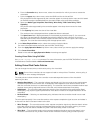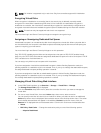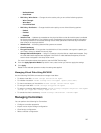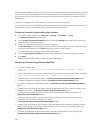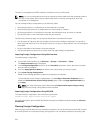
Initializing Virtual Disks
Initializing virtual disks erases the all the data on the disk but does not change the virtual disk
configuration. You must initialize a virtual disk that is configured before it is used.
NOTE: Do not initialize virtual disks when attempting to recreate an existing configuration.
You can perform a fast initialization, a full Initialization, or cancel the initialization operation.
NOTE: The cancel initialization is a real-time operation. You can cancel the initialization using only
the iDRAC Web interface and not RACADM.
Fast Initialization
The fast initialize operation initializes all physical disks included in the virtual disk. It updates the metadata
on the physical disks so that all disk space is available for future write operations. The initialize task can be
completed quickly because the existing information on the physical disks is not erased, although future
write operations overwrite any information that remains on the physical disks.
Fast initialization only deletes the boot sector and stripe information. Perform a fast initialize only if you
are constrained for time or the hard drives are new or unused. Fast Initialization takes less time to
complete (usually 30-60 seconds).
CAUTION: Performing a fast initialize causes existing data to be inaccessible.
The fast initialize task does not write zeroes to the disk blocks on the physical disks. It is because the Fast
Initialize task does not perform a write operation, it causes less degradation to the disk.
A fast initialization on a virtual disk overwrites the first and last 8 MB of the virtual disk, clearing any boot
records or partition information. The operation takes only 2-3 seconds to complete and is recommended
when you are recreating virtual disks.
A background initialization starts five minutes after the Fast Initialization is completed.
Full or Slow Initialization
The full initialization (also called slow initialize) operation initializes all physical disks included in the virtual
disk. It updates the metadata on the physical disks and erases all existing data and file systems. You can
perform a full initialization after creating the virtual disk. In comparison with the fast initialize operation,
you may want to use the full initialize if you have trouble with a physical disk or suspect that it has bad
disk blocks. The full initialize operation remaps bad blocks and writes zeroes to all disk blocks.
If full initialization of a virtual disk is performed, background initialization is not required. During full
initialization, the host is not able to access the virtual disk. If the system reboots during a full initialization,
the operation terminates and a background initialization process starts on the virtual disk.
It is always recommended to do a full initialization on drives that previously contained data. Full
initialization can take up to 1-2 minutes per GB. The speed of initialization depends on the controller
model, speed of hard drives, and the firmware version.
The full initialize task initializes one physical disk at a time.
225









